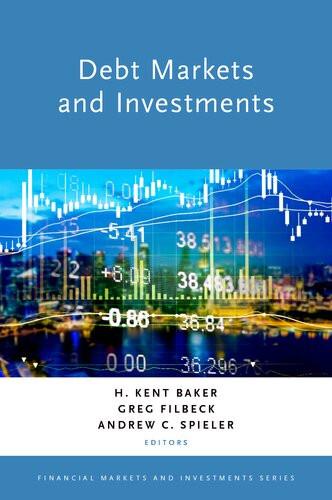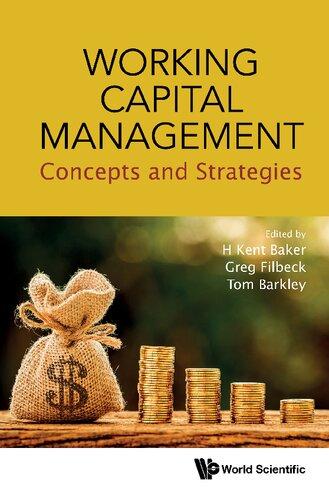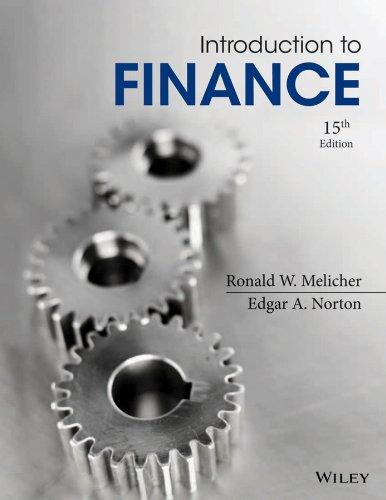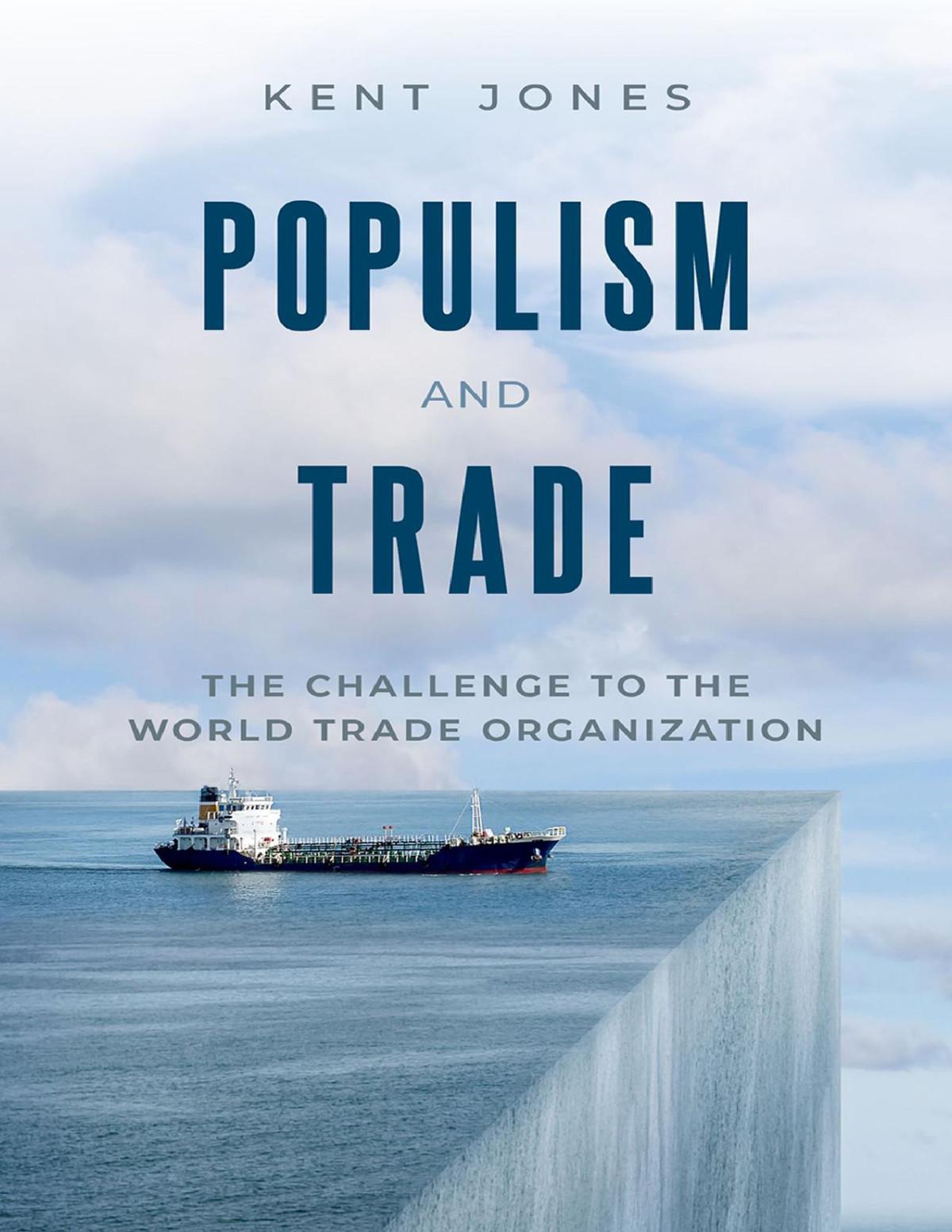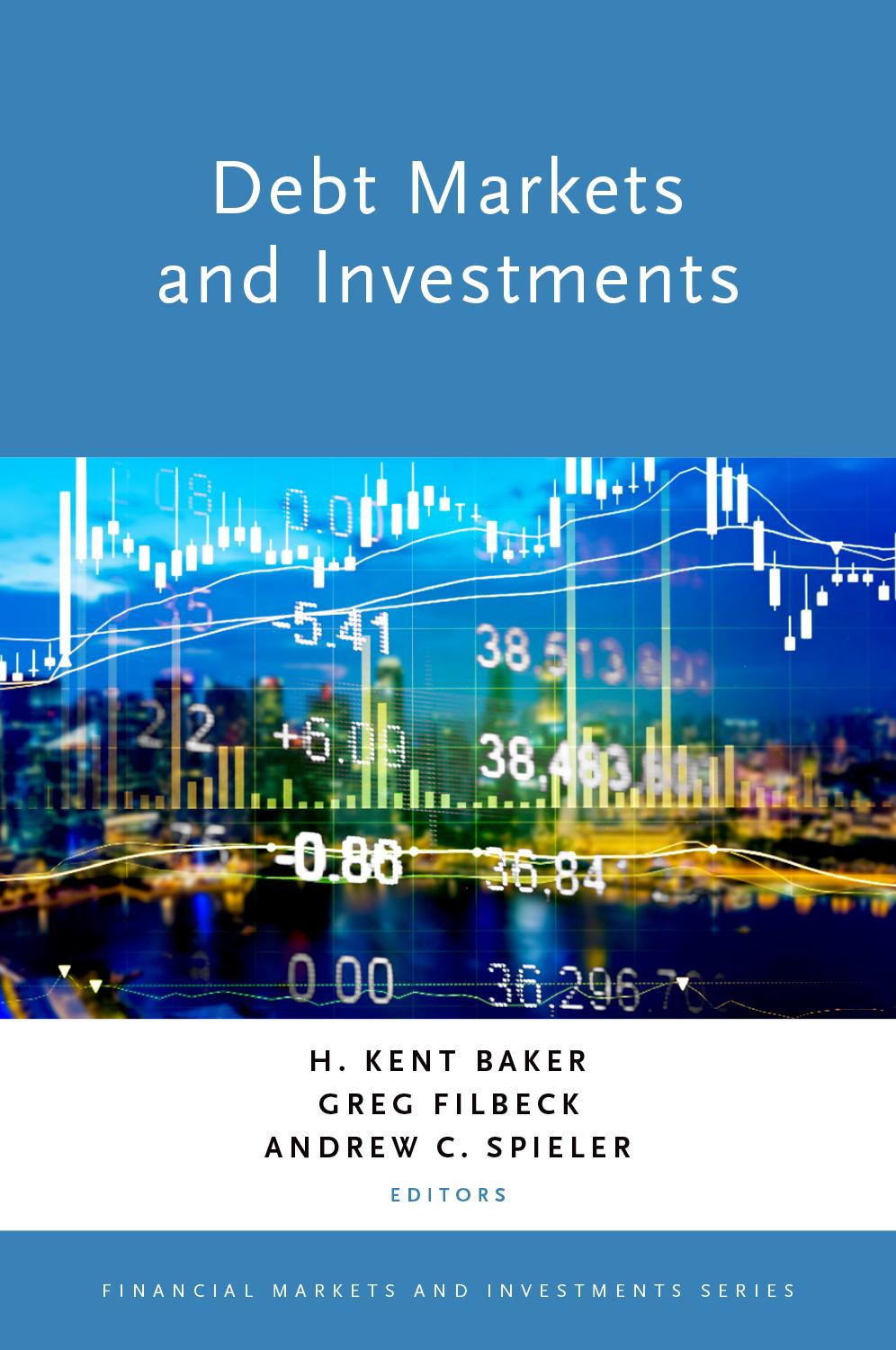Debt Markets and Investments
EDITED BY H. KENT BAKER, GREG FILBECK, AND
ANDREW C. SPIELER
Oxford University Press is a department of the University of Oxford. It furthers the University’s objective of excellence in research, scholarship, and education by publishing worldwide. Oxford is a registered trade mark of Oxford University Press in the UK and certain other countries.
Published in the United States of America by Oxford University Press 198 Madison Avenue, New York, NY 10016, United States of America.
© Oxford University Press 2019
All rights reserved. No part of this publication may be reproduced, stored in a retrieval system, or transmitted, in any form or by any means, without the prior permission in writing of Oxford University Press, or as expressly permitted by law, by license, or under terms agreed with the appropriate reproduction rights organization. Inquiries concerning reproduction outside the scope of the above should be sent to the Rights Department, Oxford University Press, at the address above.
You must not circulate this work in any other form and you must impose this same condition on any acquirer.
CIP data is on file at the Library of Congress
ISBN 978–0–19–087743–9 1 3 5 7 9 8 6 4 2
Printed by Sheridan Books, Inc., United States of America
List of Figures ix
List of Tables xiii
Acknowledgments xvii
About the Editors xix
About the Contributors xxi
CONTENTS
PART I BACKGROUND
1. Debt Markets and Investments: An Overview 3
H. Kent Baker, Greg Filbeck, and Andrew C. Spieler
2. Debt Fundamentals and Indices 23
Ryan J. Dodge, Steven T. Petra, and Andrew C. Spieler
3. Interest Rate Risk, Measurement, and Management 41
Tom Barkley
4. Other Risks Associated with Debt Securities 63
Randolph D. Nordby
PART II MARKET SECTORS
5. Government Debt 81
Keith Pareti and Rob Kennedy
6. Municipal Bonds 95
Xiaohu Deng, Christopher Goebert, Gershon Morgulis, and Isaac Yates
7. Corporate Bond Markets 113
Kelly E. Carter
8. Securitized Debt Markets 131
Şenay Ağca and Saiyid S. Islam
9. Derivatives Markets 151
Halil Kiymaz and Koray D. Simsek
10. Short-Term Funding and Financing Alternatives 167
Benjamin Aguilar, Ajit Jain, and Kevin Neaves
11. Private Debt Markets 185
Douglas Cumming, Grant Fleming, and Zhangxin (Frank) Liu
PART III YIELD CURVES, SWAP CURVES, AND INTEREST RATE MODELS
12. Yield Curves, Swap Curves, and Term Structure of Interest Rates 203
Tom P. Davis and Dmitri Mossessian
13. Models of the Yield Curve and Term Structure 229
Tom P. Davis and Dmitri Mossessian
PART IV BOND PRODUCTS
14. International Bonds 249
Soutonnoma Ouedraogo, David Scofield, and Garrett C. Smith
15. Floating Rate Notes 265
Aby Abraham, John Casares, and Jibran Ali Shah
16. Bonds with Embedded Options 283
Christopher J. Barnes, Gaurav Gupta, and Joseph F. Abinanti
17. Bond Mutual Funds, Closed-End Bond Funds, and Exchange-Traded Funds 305
Halil Kiymaz and Koray D. Simsek
18. Other Bond Products: Social Impact Bonds, Death Bonds, Catastrophe Bonds, Green Bonds, and Covered Bonds 325
Erik Devos, Robert Karpowicz, and Andrew C. Spieler
19. Inflation-Linked Bonds 345
John Lettieri, Gerald O’Donnell, Seow Eng Ong, and Desmond Tsang
PART V SECURITIZED PRODUCTS
20. Securitization Process 365
Mark Ferguson, Joseph McBride, and Kevin Tripp
21. Mortgage-Backed Securities: Mortgage Pass-Through Securities 383
Mingwei (Max) Liang and Milena Petrova
22. Asset-Backed Securities 403
Massimo Guidolin and Manuela Pedio
23. Collateralized Debt Obligations, Collateralized Bond Obligations, and Collateralized Loan Obligations 421
Robert Eckrote, Christopher Milliken, Ehsan Nikbakht, and Andrew C. Spieler
PART VI
BOND VALUATION AND ANALYSIS
24. Factors Affecting Bond Pricing and Valuation 437
Mark Wu, Xiang Gao, and Robert Wieczorek II
25. Valuing and Analyzing Bonds with Embedded Options 453
Yiying Cheng
26. Valuing and Analyzing Mortgage-Backed and Asset-Backed Securities 477
Matthew Dyer
27. Valuing and Analyzing Fixed Income Derivatives 501
Koray D. Simsek and Halil Kiymaz
PART VII SPECIAL TOPICS
28. Credit Analysis and Ratings 523
Peter Dadalt, Michael Gueli, Rafay Khalid, and Ling Zhang
29. Bond Auctions 547
Mark Wu, Patrick Herb, and Shishir Paudel
30. Bond Accounting 567
Oluwaseyi Adebayo Awoga
31. High Yield Bonds 599
Byron C. Barnes, Tony Calenda, and Elvis Rodriguez
32. Distressed Debt 621
Seoyoung Kim
33. Microstructure of Fixed Income Trading 639
Matthew John Jerabeck, Marc Perkins, and David Petruzzellis
34. Debt Investment Strategies 661
Steven Cosares, Taylor Riggs, and Andrew C. Spieler
35. Debt Portfolio Management 679
Zachary Jersky and He Li
36. Debt Trends and Future Outlook 699
Dianna Preece
Discussion Questions and Answers 717 Index 763
FIGURES
3.1 Macaulay Duration: A Representation of Cash Flows 46
3.2 Macaulay Duration versus Maturity 48
3.3 Modified Duration Approximation 50
3.4 Properties of Convexity 53
8.1 A Simplified Securitized Debt Transaction Structure 133
8.2 Residential Mortgage Backed Securities (RMBS) Issuance 139
8.3 Types of U.S. Non-Agency Securitized Debt Issuance in 2017 146
8.4 Global Share of Non-Agency Securitized Debt Issuance in 2017 147
8.5 Recent Non-Agency Securitized Debt Issuance in the Three Largest Markets 147
9.1 Growth of the Over-the-Counter Interest Rate Derivatives Markets 152
9.2 Daily Average Turnover for Interest Rate Derivatives 153
9.3 Exchange-Traded Interest Rate Derivatives 154
9.4 Key Dates for an FRA 156
10.1 Purchase Order Financing Mechanics Illustration 175
11.1 Firm Size, Information Availability, and Types of Private Debt 186
12.1 Spline Instability 211
12.2 Fitted U.S. Treasury Curve for June 8, 2017, Together with Market Quoted Yields for All Traded Notes and Bonds 218
12.3 Time Series of the Spreads to a Fitted Curve 219
12.4 European Basis Spreads Before and After the Global Financial Crisis 222
12.5 EURIBOR Projection Curves and EONIA Discounting Curves for September 20, 2017 224
15.1 Plain Floating Rate Note 269
15.2 Capped Floating Rate Note 270
15.3 Floored Floating Rate Note 271
15.4 Collared Floating Rate Note 271
16.1 Profit Diagrams of Long/Short Call/Put Options 286
16.2 Price-Yield Relation for Callable, Puttable, and Option-Free Bonds 290
16.3 Convertible Issuance by Region between 2005 and 2016 293
16.4 Implied Market Capitalization of Outstanding Convertible Bonds by Sector 294
16.5 Convertible Bond Price Performance versus S&P 500 Index 295
16.6 Convertible Arbitrage Fund Assets under Management between 2000 and 2017 296
16.7 Relation Between Convertible Bond and Underlying Equity 297
16.8 Extendible Bond Issuance by Sector, between 2005 and 2017 300
17.1 Net Issuance of Mutual Fund Shares by Investment Classification 308
17.2 Net Issuance of CEF Shares by Investment Classification 315
17.3 Net Issuance of ETF Shares by Investment Classification 317
18.1 Social Impact Bond 328
18.2 Death Bond Structure 335
18.3 Catastrophe Bond Structure 339
20.1 End-of-Period Data from the Federal Reserve on Mortgage Pools and Trusts 371
20.2 Data on ABS Issuance by Asset Class 372
20.3 Graphic Representation of Different Risk and Return for Investors in a Mortgage-Backed CDO 374
21.1 Annual Mortgage-Related Securities Outstanding 385
21.2 Annual Mortgage-Related Securities Issuance 385
21.3 PSA Prepayment Model 397
21.4 Cash Flow Patterns of Three PSA Models 398
22.1 ABS Issuances in the United States between 1985 and 2016 404
22.2 Key Differences between Auto Loans and Auto Leases 412
22.3 Auto Lease Securitization Process 413
24.1 New Bond and Equity Issuance 438
24.2 Yield Curve Shapes 440
24.3 CDS Notional Amount 447
25.1 Callable Convertible Bond Issued by ALZA Corp. 455
25.2 Annual Issuance of Callable and Convertible Bonds between 1996 and 2016 456
25.3 Price Compression in a Callable Bond 456
25.4 Hypothetical Z- Spread Illustration 460
25.5 One- Step Binomial Tree 461
25.6 Binomial Tree Setup 462
25.7 Binomial Tree Calibration at Six Months: Setup 464
25.8 Binomial Tree Calibration at Six Months: Results 465
25.9 Binomial Tree Calibration at One Year: Setup 466
25.10 Binomial Tree Calibration at One Year: Results 467
25.11 Binomial Tree Application: Callable Bond Valuation 468
25.12 Binomial Tree Application: Puttable Bond Valuation 469
25.13 Convertible Bonds of A-Rating Issuers 472
26.1 Varying CPR Ramps Associated with Different PSA “Speeds” 483
26.2 Hypothetical S-Curve Function Illustrating a Fixed-Rate MBS’s Refinancing Incentive over Various Levels of Interest Rates 486
26.3 Graphical Depiction of a 100 Percent Standard Default Assumption 491
27.1 Evolution of the TED Spread between 2004 and 2018 502
28.1 Cash Conversion Cycle 530
29.1 Issuance of Treasury Securities 548
29.2 Discriminatory Auction versus Uniform-Price Auction 555
31.1 Issuance by Credit Rating Based on Value 601
31.2 High Yield Bond Issuance by Year (USD in Millions) 602
31.3 Correlation of High Yield Bond Return versus U.S. Equities 603
31.4 High Yield Default Rates 606
31.5 Cross-Asset Total Return Performance between December 31, 2005, and September 30, 2017 607
31.6 T-Mobile Preliminary Prospectus Cover Excerpt 609
32.1 Global Percentage Default Rates over Time 622
32.2 Debt and Equity as a Function of Underlying Firm Value 623
34.1 10-Year AAA Municipal Yield as a Percentage of a 10-Year Treasury Yield 669
34.2 Two-Year, 10-Year, and 30-Year Treasury Yields 673
34.3 Global High Yield Total Return Index versus U.S. Treasury Total Return Index 675
34.4 Spread between 10-Year BBB U.S. Corporate Yields and 10-Year Treasury Yields 675
TABLES
3.1 Total Return on a Bond Investment 43
3.2 Key Factors Affecting Price Risk and Reinvestment Risk 45
4.1 Analyzing the Credit Quality of Vanguard Long-Term Investment-Grade Fund Investor 70
4.2 Example of Credit Capacity 72
4.3 Some Environmental, Social, and Governance Issues Affecting Credit Risk 76
7.1 Moody’s Corporation’s Issuer Credit Rating Categories and Definitions 121
7.2 S&P Corporation’s Issuer Credit Rating Categories and Definitions 122
7.3 Fitch Corporation’s Issuer Credit Rating Categories and Definitions 123
7.4 DRBS Issuer Credit Rating Categories and Definitions 124
9.1 Size of the Over-the-Counter Interest Rate Derivatives Markets by Instrument Types 155
9.2 Plain Vanilla Interest Rate Swap Rates Quoted in the U.S. Markets on January 11, 2018 157
9.3 Most Popular Interest Rate Futures Contracts in 2016 160
9.4 Most Popular Interest Rate Options on Futures Contracts in 2016 162
10.1 Example of Purchase Order Financing 176
10.2 Example of a Revolving Credit Facility 179
11.1 Types of Syndicated Loans 188
11.2 Private Debt Investors by Type 188
14.1 Sovereign Credit Ratings 258
16.1 Convertible Option Exercise Decisions 292
17.1 Investment Company Types 306
17.2 Number of Investment Companies by Type 307
19.1 Key Features of Inflation-Linked Bonds 352
19.2 Treasury versus TIPS When the Realized Inflation Exceeds the Break-Even Inflation Rate 357
19.3 Treasury versus TIPS: Realized Inflation Equals Break-Even Inflation Rate 358
19.4 Treasury versus TIPS When the Break-Even Inflation Rate Exceeds Realized Inflation 359
21.1 Average Daily Trading Volume of MBSs versus Other Fixed Income Securities 386
25.1 Summary of Bond Provisions 454
25.2 Illustration of the Yields in the Example 463
27.1 Example for Bootstrapping the LIBOR Forward Curve with OIS Discounting 504
27.2 Example for Valuation of an FRA 506
27.3 Example for Valuation of an Off-Market Interest Rate Swap 507
27.4 Convexity Adjustment between Futures and Forward Rates 509
28.1 Five Cs in Practice: Balance Sheet 526
28.2 Five Cs in Practice: Income Statement 526
28.3 Five Cs in Practice: Cash Flow Statement 527
28.4 Financial Analysis in Practice: Income Statement 540
28.5 Financial Analysis in Practice: Balance Sheet 541
28.6 Financial Analysis in Practice: Statement of Cash Flow 542
28.7 Financial Analysis in Practice: Ratios 543
29.1 Auction Schedule 550
29.2 List of Current Primary Dealers 551
29.3 Example of Auction Announcement and Auction Results 553
29.4 Treasury Auction Format 556
29.5 Summary of Average Underpricing in Empirical Studies 562
30.1 Examples of Fixed Rate Bonds Issued at Par, Premium, and Discount 569
30.2 Examples of Floating Rate Notes Issued at Par, Premium, and Discount 570
30.3 Sample Presentation of a Bond Liability at Book Value 571
30.4 Duration Hedging of the Balance Sheet 574
30.5 Analysis of Fixed Rate Bond 577
30.6 Accounting Entries to Record Issuance of a $5 Billion Bond at 99.457 Percent 577
30.7 Amortization Calculations Using the Effective Interest Method 578
30.8 Accounting Entries to Record Interest Expense on July 26, 2017 579
30.9 Presentation of Bond Liability at Book Value as of July 26, 2017 579
30.10 Fair Market Value Calculations as of January 28, 2018 580
30.11 Accounting Entries to Record Bond Retirement on January 26, 2018 581
30.12 Analysis of Zero-Coupon Bond with Issuance Cost 581
30.13 Accounting Entries to Record Zero Coupon Issuance on July 1, 2014 582
30.14 Zero-Coupon Bond Amortization Using the Effective Interest Method 583
30.15 Zero-Coupon Bond Issuance Cost Amortization Using the Effective Interest Method 584
30.16 Accounting Entries to Record Interest Expense and Issuance Cost Amortization on July 1, 2015 586
30.17 Presentation of Zero-Coupon Bond Liability at Book Value as of July 26, 2017 586
30.18 Analysis of a Floating Rate Note Issued at a Premium 588
30.19 Accounting Entries to Record Issuance of €900,000,000 FRN at 100.5671 Percent on December 21, 2016 588
30.20 FRN Amortization Using the Effective Interest Rate Method 589
30.21 Accounting Entries to Record Interest Income on March 21, 2017 591
30.22 FRN Amortization Using the Effective Interest Rate Method After Interest Rate Reset 592
30.23 Analysis of an Interest Rate Swap Entered to Hedge Bond Investments 594
30.24
Accounting Entries to Record Bond Investment on January 1, 2000 595
30.25 Accounting Entries to Interest Income and Expenses on March 31, 2000 596
30.26 Accounting Entries to Record Fair Value Changes on March 31, 2000 596
31.1 Credit Rating Agency Scale—Long Term Rating 601
31.2 T-Mobile Bonds Outstanding 616
32.1 Example of Possible Payouts under Financial Distress 625
32.2 Example of Possible Payouts with Risky Asset Substitution 625
32.3 Another Example of Payouts under Financial Distress 626
32.4 Payouts of Potential Investment Opportunities 627
32.5. Payout to Stakeholders If the Firm Invests in Both Opportunities 627
32.6 Payout to Stakeholders If the Firm Only Invests in Opportunity A 627
32.7 Payout to Stakeholders If the Firm Invests in Both Opportunities and Receives a Principal Write-Down on Its Debt 628
33.1 List of Primary Dealers 644
34.1 Average Growth Rate above Inflation Required for Drawdown Rate to Last Desired Time Frame 668
34.2 Holders of Municipal Securities (in Billions of USD) 670
35.1 Inter-Year Average Yield of Major Bond Indices and the S&P 500 Composite Index, 2007–2016 680
35.2 Pure Discount Bond Price Sensitivity and Macaulay Duration 684
35.3 Duration of Bonds with Different Coupon Rates under Different Discount Rates 684
35.4 Duration and Convexity 686
35.5 Bond Value at Year 5 690
ACKNOWLEDGMENTS
You write to communicate to the hearts and minds of others what’s burning inside you, and we edit to let the fire show through the smoke.
Arthur Plotnik
As the editors of Debt Markets and Investments, we greatly appreciate all those who played a part in bringing this book from the idea stage to publication. In particular, we want to thank several groups and individuals. To the reviewers of the book proposal, we valued your input, which ultimately led to a better book. To the chapter authors, who collectively invested several thousands of hours of their time, we are indebted for your insights and perseverance. To our partners at Oxford University Press, we are grateful for your professionalism throughout the process. Our special thanks go to David Pervin (Senior Editor), Macey Fairchild (Editorial Assistant), Felshiya Bach (Senior Project Manager), and Elizabeth Bortka (Copyeditor) but others contributed substantially this book project. To our respective institutions—the Kogod School of Business at American University, the Behrend College at Penn State–Erie, and the Frank G. Zarb School of Business at Hofstra University, we appreciate the research support. Finally, to our families, we appreciate their support and sacrifices: Linda and Rory Baker; Janis, Aaron, Andrea, Kyle, and Grant Filbeck; and Terry, Harrison, Teresa, Robin, Kate, and Hudson Spieler.
ABOUT THE CONTRIBUTORS
Joseph F. Abinanti is Director of U.S. Wealth Advisory for Muzinich & Co., a global fixed income manager based in New York City. Before joining Muzinich, he was an investment consultant for UBS Asset Management, where he represented UBS Asset Management’s investment capabilities including mutual funds, separately managed accounts, and hedge funds (single manager O’Connor and Fund of Funds A&Q) portfolios. Before joining UBS Asset Management, he served in various roles throughout JPMorgan and Morgan Stanley, which included analyzing investment portfolios and reviewing asset allocations, client risk tolerances, and objectives. Mr. Abinanti holds a BA in psychology from Binghamton University.
Aby Abraham is an independent financial consultant with more than 17 years of experience working in the financial services industry. He specializes in both retail and fixed income securities, specifically mortgage securities traded in the secondary market. He has also held roles in the servicing, due diligence, and trade support functions of various financial institutions including investment banks, local credit unions, and rating agencies. Mr. Abraham received a BBA from the Zicklin School of Business at the City University of New York at Baruch College and an MBA from the Frank G. Zarb School of Business at Hofstra University.
Şenay Ağca is an Associate Professor of Finance at the George Washington University. Her research interests include credit risk, corporate finance, and macro-finance. She has taught undergraduate, graduate, and executive level courses on fixed income securities, corporate finance, and money and capital markets. Her research has been published in the Journal of Financial and Quantitative Analysis, Journal of International Economics, Journal of Banking and Finance, Journal of Financial Research, Journal of Derivatives among others. Professor Ağca has received various grants and awards such as the J. Wendell and Louise Crain Research Fellowship, GW-CIBER research grants, American Consortium on European Union Studies grant, GW-Institute for Corporate Responsibility grant, and Dean’s scholarship. She has also worked as a visiting scholar at the International Monetary Fund and Sciences Po, Paris. Professor Ağca received a PhD from Virginia Tech.
Benjamin Aguilar, CFA, is the Treasury and Finance Manager at Ports America, the largest terminal operator and stevedore in the United States. He has more than a decade
of debt capital markets experience. Mr. Aguilar is responsible for overseeing the management of Ports America’s short-term liquidity and long-term debt capital structure. In his previous role, he oversaw debt and equity transactions as a mergers and acquisitions (M&As) advisor. Before that, he worked for the largest independently owned factor and asset-based lender in the United States. Mr. Aguilar has also served as an adjunct professor of finance at The King’s College teaching business valuation and capital structure and has been a contributing author to an educational finance book. He has a BA in economics from The King’s College.
Oluwaseyi Adebayo Awoga, CPA, PRM, is a Senior Finance Professional with experience in financial accounting and analysis, fixed income, derivatives, research, valuation, and risk management. His professional experience spans public accounting and the financial services industry. He previously worked at Deloitte and PriceWaterhouseCoopers and financial services institutions where he solved complex and strategic business problems in different functional areas of a business such as accounting, auditing finance, valuation, risk management, and analytics. In his spare time, he researches and writes on fixed income, finance, and accounting topics. He holds a master of accountancy degree from Bowling Green State University and is currently completing a master of science in financial engineering at WorldQuant University.
Tom Barkley, CFA, FRM, CAIA, is a Professor of Finance Practice at the Whitman School of Management, Syracuse University, and is also the director of the MS in Finance program. His teaching and research are in corporate finance and derivatives. He previously worked for Enron (Research Group) and the Risk Analytics Group at Florida Power & Light. In both cases, his work included pricing exotic options and structuring products for use in the energy markets. Other experience includes retail banking in the United Kingdom, teaching high school mathematics in the Bahamas, and general management of a family-run publishing company. He received an MBA from Thunderbird, the American Graduate School of International Management, and a PhD in finance from the University of Florida.
Byron C. Barnes is a Vice President in the Middle Market Banking Group at Wells Fargo Bank, N.A., where he sources, analyzes, structures, and monitors debt investments in middle market businesses. Before joining Wells Fargo, Mr. Barnes held credit underwriting and portfolio management roles in corporate banking at PNC Bank, facilitating debt financing for large corporations in various industries. Previously, he worked in reinsurance brokerage, insurance underwriting, and risk management consulting. Mr. Barnes is a member of the CFA Institute and the CFA Society of Washington, DC. He received bachelor’s degrees in finance and Spanish from Oakwood University, where he graduated magna cum laude, and received an MBA from the William E. Simon Graduate School of Business, University of Rochester, where he was a Robert Toigo Foundation Fellow.
Christopher J. Barnes, CFA, is an equity research associate at Deutsche Bank on the North America beverages, household products, and tobacco team. He has broadbased consumer sector experience analyzing public equity investments. Before joining Deutsche Bank, he evaluated the media and entertainment and hardlines and broadlines
retailing sectors at Telsey Advisory Group. He also analyzed the consumer leisure sector at Oppenheimer & Co. Mr. Barnes began his career in J.P. Morgan’s Global Rates and FX Derivatives division. He received a BBA in finance with high honors from Hofstra University.
Tony Calenda, CFA, CAIA, CPA/ABV, FRM, CIFD, is the head of Special Projects at Geller & Company, a financial services and wealth management firm serving private wealth owners as well as business owners and senior managers who are responsible for the financial affairs of a company. Before joining Geller & Company, Mr. Calenda was a member of the executive management team of SunGard, providing technology solutions to the wealth management industry. He was also a senior executive at American Express, Macquarie Holdings, CME Group, and Citigroup. He began his career at McKinsey & Company consulting to financial services companies. Mr. Calenda is a member of the CFA Institute, CFA Society New York, CAIA Association, Global Association of Risk Professionals, American Institute of Certified Public Accountants, Institute of Management Accountants, and Certified Investment Fund Director Institute, and has qualified as a FINRA-registered securities principal. He is an Adjunct Professor of Business at Fordham University. He has a BA in economics from Columbia University, where he was elected to Phi Beta Kappa, and an MBA from Stanford University.
Kelly E. Carter is an Associate Professor of Finance at Morgan State University in Baltimore, Maryland. Before entering academia, he worked as a consultant for Andersen Consulting (now Accenture) and Citigroup and as an analyst at Lucent Technologies. He primarily teaches courses in securities analysis and portfolio management and introductory corporate finance. Professor Carter has published in Accounting Horizons, Journal of Accounting and Finance, and Managerial and Decision Economics. He holds a BS in actuarial science from Florida A&M University, an MBA and an MS from the University of Maryland, and a PhD in finance from the University of South Florida.
John Casares is an independent financial consultant and a retired U.S. army infantry officer. He has served tours of duty in Iraq, Afghanistan, Republic of Korea, Kuwait, Colombia, and El Salvador. He is a recipient of the Bronze Star Medal. Mr. Casares is a distinguished military graduate from Fordham University Army ROTC and former Cadet Commander for Fordham University and St. John’s University ROTC programs. He is also a lifetime member of the Pershing Rifles honor society and Beta Gamma Sigma honor society. Mr. Casares also served as Co-President to Hofstra University’s Beta Gamma Sigma chapter. He holds a certificate of completion for the Bloomberg Essentials Training Program in foreign exchange and is a Lean Six Sigma Master Black Belt. Mr. Casares holds a BS from John Jay College of Criminal Justice, a master of military arts and science from the U.S. Army’s Command and General Staff College, a master of science in finance from the Zicklin School of Business at Baruch College, and an MBA with distinction from Frank G. Zarb School of Business at Hofstra University.
Yiying Cheng, CFA, is an Assistant Professor of Finance at the Cameron School of Business, University of St. Thomas–Houston. Professor Cheng’s research focuses on derivatives markets, fixed income, and real estate. She has published in the Journal of Fixed Income. Professor Cheng has presented her research at annual meetings of the
Financial Management Association, Midwest Finance Association, American Real Estate Society, and Eastern Finance Association. She received a PhD in finance from the University of North Carolina–Charlotte and a PhD in physics from the University of Rhode Island.
Steven Cosares is a Professor of Mathematics and Computer Science at CUNY’s LaGuardia Community College. His interests in the applications of quantitative modeling and optimization brought him to the topic of decision support systems for investment planning. Over the last decade, he has provided management consulting support and has published articles on the topic. His work has appeared in scholarly journals including Operations Research, Journal of Wealth Management, and Interfaces. He received undergraduate degrees in applied math and computer science from SUNY Stony Brook and a PhD in operations research from the University of California–Berkeley.
Douglas Cumming, CFA, is the DeSantis Distinguished Professor at the College of Business, Florida Atlantic University. He is the Managing Editor-in-Chief of the Journal of Corporate Finance. His research interests include venture capital, private equity, hedge funds, entrepreneurship, fixed-income securities, and law and finance. His research has appeared in the Journal of Financial Economics, Review of Financial Studies, Journal of International Business Studies, and Journal of Corporate Finance. He is a research associate with the Bocconi University Paolo Baffi Center for Central Banking and Financial Regulation (Milan), Groupe d’Economie Mondiale at Sciences Po (Paris), Capital Markets CRC (Sydney), Venture Capital Experts (New York), Cambridge University ESRC Centre for Business Research (Cambridge, UK), Center for Financial Studies (Frankfurt), Amsterdam Center for Research in International Finance, and the University of Calgary Van Horne Institute. He received a BCom (Honors) in economics and finance from McGill University, an MA in economics from Queen’s University, a JD from the University of Toronto, and a PhD in economics and finance from the University of Toronto.
Peter Dadalt, CFA, is an Assistant Professor of Finance in the Sigmund Weiss School of Business at Susquehanna University. In his 20-year academic career, he has published academic research in such areas as corporate debt markets, board structure and composition, earnings management, and risk management. He teaches classes in investment analysis, portfolio management, fixed income markets, and financial modeling. He holds a PhD in finance from Georgia State University.
Tom P. Davis joined FactSet in 2014 as the Director of Fixed Income and Derivatives Research, focusing the quality and breadth of FactSet’s analytical models, and performing research in quantitative finance. Dr. Davis has extensive experience with derivatives analytics, having worked for more than a decade for several of the industry’s leading providers. He received a PhD in theoretical physics from the University of British Columbia.
Xiaohu Deng is an Assistant Professor of Finance in the Tasmanian School of Business and Economics at the University of Tasmania in Australia. He previously served on the faculty at Ohio University. Professor Deng’s research focuses on corporate finance and short selling. His work on the real effects of short selling constraints is recognized both
nationally and internationally. His research has also appeared in the Oxford Law Blog, ValueWalk, and Quant News. He is frequently invited to present his research at prestigious conferences and universities. Professor Deng received an undergraduate degree in management from Wuhan University (China), an MS in quantitative finance from Hofstra University, and a PhD from the University of Memphis.
Erik Devos is the Ellis and Susan Mayfield Chair in Business Administration and Professor of Finance at the College of Business Administration of the University of Texas–El Paso. He previously taught at Ohio University and Binghamton University (SUNY). He has published in finance and accounting journals including Review of Financial Studies, Journal of Accounting and Economics, Journal of Corporate Finance, Financial Management, and Journal of Banking and Finance. He has also published in real estate journals such as Real Estate Economics, Journal of Real Estate Economics and Finance, and Journal of Real Estate Research. Professor Devos serves as an associate editor for the Financial Review. He received a master’s degree in financial economics from Erasmus University in Rotterdam and a PhD in finance from Binghamton University (SUNY).
Ryan J. Dodge, CFA, is an Investment Analyst at Wilkinson Global Asset Management LLC in New York, where he is a member of the investment committee. He received a BS from the University of Virginia, graduating from the McIntire School of Commerce with concentrations in the areas of finance and management.
Matthew Dyer, CFA, is an analyst with Morgan Stanley’s Private Wealth Management division where he and his team collectively oversee and manage $1.5 billion in assets under management catering to both institutional investors and ultra-high net worth individuals. Within the team, Matt specializes in portfolio valuation and asset allocation. He previously worked at Credit Suisse within the Private Banking and Wealth Management division where he operated in a similar capacity. He is a member of the CFA Society New York. Mr. Dyer graduated with a BS from St. Lawrence University with a double major in economics and government and a minor in Asian studies.
Robert Eckrote, CFA, is an industry professional and Senior Associate for Hennion & Walsh Asset Management’s Portfolio Management Program. Hennion & Walsh Asset Management is a Registered Investment Advisory firm that uses ETFs to construct investment strategies. Mr. Eckrote works under the chief investment officer and conducts research on capital markets and asset allocation strategy, while focusing on product selection. He received a BS in business administration with a concentration in entrepreneurship from Fordham University.
Mark Ferguson is an independent consultant focused on the quantitative aspects of investments and their risk management. He previously served as Senior Quantitative Analyst and later Research Director at Quantifi, Inc., which specializes in software for pricing and risk management of credit derivatives. Mr. Ferguson has an MA in business research from Stanford University and an MA in probability and statistics from Indiana University.
Grant Fleming is Partner at Continuity Capital Partners in Canberra, Australia. Before cofounding the firm, he held investment positions at Wilshire Associates Inc. and academic positions at Australian National University and the University of Auckland. He has published extensively in finance and business history journals including Business History, Business History Review, Economic History Review, Financial Management, Journal of Business Ethics, Journal of Corporate Finance, Journal of Fixed Income, and Journal of Monetary Economics. He received a PhD in economics from the University of Auckland.
Xiang Gao, CFA, FRM, is a financial economist whose research interests include corporate finance, investments, debt markets, and financial derivatives. His current research focuses on how clientele effects in financial markets influence a firm’s financing decision. He has presented his research at leading finance conferences such as Financial Management Association. He received a BS in finance from Shandong University of Finance and Economics and an MS in finance from University of Maryland. He is currently a PhD candidate in finance at State University of New York at Binghamton. He joined the Paseka School of Business, Minnesota State University—Moorhead as an Assistant Professor of Finance in 2019.
Christopher Goebert is the Director of the GDI Advisory Group, PTE LTD. He is the director of a security consultancy firm in Singapore and is retired from the New York State Police and United States Army Special Operations Forces. During his career, Mr. Goebert deployed worldwide providing insight for policymakers about corruption and associated monetary activities. As a consultant, he currently provides support to operations for various government and multinational clients. Besides several military and law enforcement qualifications, Mr. Goebert received a BS in criminal justice and is pursuing an MBA at Syracuse University.
Michael Gueli is a Vice President for the Portfolio Management team at JPMorgan Chase & Co.’s Global Real Estate division and is responsible for acquisition and disposition work for the firm’s owned portfolio of assets. Mr. Gueli has transacted on more than $500 million of commercial office, data center, and retail assets for office towers, tier 3+ data halls, and retail redevelopment strategies. He previously worked on the Middle Market and Specialized Industries team as a credit analyst for the firm, largely focused on Metro New York area retail and apparel clients. Mr. Gueli graduated summa cum laude with a BBA in finance from Hofstra University.
Massimo Guidolin is a Professor of Finance at Bocconi University, where he teaches econometrics and asset pricing. He also teaches portfolio management at SDA Bocconi. Professor Guidolin previously held senior positions with the Federal Reserve Bank of Saint Louis and Manchester Business School. His research interests include nonlinear time series models, asset pricing, and dynamic portfolio choice. Professor Guidolin has published in such outlets as the Journal of Financial Economics and Journal of Econometrics. He serves on the editorial board of several journals including the Journal of Economic Dynamics and Control and International Journal of Forecasting. He received a PhD in economics from the University of California– San Diego.
Gaurav Gupta, CFA, FRM, is a Senior BI Consultant at SRNL International. Before joining SRNL, he worked as an analyst at OpenLink Financial, LLC, a data analyst at
Cablevision Systems Corporation and as a manager in his family’s steel manufacturing plant in India. He has published in a textbook on hedge funds and the Journal of International Business and Law. He received a bachelor’s degree in biotechnology engineering from Panjab University and an MBA in finance and business analytics with distinction and honors from Hofstra University. He is a member of CFA Society New York, the Hedge Fund Association, and Beta Gamma Sigma Honor Society.
Patrick Herb is Assistant Professor of Finance in the W.A. Franke College of Business at Northern Arizona University. His research focuses on capital markets, asset pricing, debt issuance, and exchange rate dynamics. He received a PhD and MS in international economics and finance from Brandeis University, after receiving a BA and BS in mathematics and economics from the University of Washington.
Saiyid S. Islam is a Director in the Quantitative Analytics group at S&P Global Ratings and has more than 15 years of experience in quantitative credit modeling. He has also taught classes on financial theory and research as an adjunct professor at the George Washington University and published nonproprietary research in journals such as the Journal of Derivatives, Journal of Banking and Finance, and the Journal of Alternative Investments, along with contributing a chapter on Credit Portfolio Insurance in the Encyclopedia of Quantitative Finance. He graduated from École Supérieure des Sciences Économiques et Commerciales (ESSEC) and completed a PhD in finance from Virginia Tech.
Ajit Jain, CPA, is an assurance manager for the real estate practice group at RSM US LLP, which is fifth largest accounting, tax and consulting services firm in the United States. Over the past 16 years, he has served clients in the real estate, mutual funds, private equity funds, and financial institutions sectors. Mr. Jain is primarily responsible for coordinating and executing financial statement audit and assurance engagements in accordance with GAAP and GAAS. He also prepares partnership and corporation tax returns, performs due diligence, valuation, cash flow and family business analysis, and reviews leases, mortgage loans, and LLC agreements. Mr. Jain is a CPA, a Chartered Accountant from India, and a Level III candidate in the CFA program.
Matthew John Jerabeck is an independent financial consultant working for a major U.S. bank. He specializes in guiding financial advisors to more efficient solutions for their businesses. He received a BBA with a major in finance from the Frank G. Zarb School of Business at Hofstra University and is a currently a CFA Level II candidate in the CFA program.
Zachary Jersky is an Investment Analyst for JPMorgan Asset Management’s U.S. Equity group, where he performs generalist research capabilities and contributes to the communication of client assets. Mr. Jersky previously held various internships at PricewaterhouseCoopers, the Danaher Corporation, and the U.S. House of Representatives. He has a BS in economics from the Wharton School of Business at the University of Pennsylvania with concentrations in finance and management. Mr. Jersky has completed all three levels of the CFA curriculum.
Robert Karpowicz, PE (ME, EE) CWI, is the Quality Control Manager and a Project Manager at Fresh Meadow Mechanical Corp. He specializes in commercial and industrial HVAC applications, power generation, and cogeneration. He has completed the professional engineering examinations in the mechanical field for thermodynamics and thermal fluids and the electrical fields for power transmission and distribution. Mr. Karpowicz is an American Welding Society Certified Welding Inspector and has passed all three levels of the CFA examination. He received a BS in mechanical engineering from Rochester Institute of Technology.
Rob Kennedy, CFA, CAIA, is an Investment Analyst for Credit Value Partners, a subsidiary of New York Life Investment Management. He is responsible for conducting fundamental research analysis and investment due diligence in the leveraged loan and high yield markets as well as evaluating private investment opportunities. Mr. Kennedy has more than 12 years of market experience and previously worked in different roles within the financial services industry. For example, at Greenwich Associates, he oversaw the marketing efforts for the markets sector, assisted in relationship management activities, and helped develop financial research for buy-side clients. He was also a U.S. Treasury derivatives trader and a long/short equity trader. Mr. Kennedy holds a BA in history from Trinity College, an MS in finance from Cass Business School, and an MS in management, organizations, and governance from the London School of Economics and Political Science.
Rafay Khalid, CFA, is a Senior Industry Credit Analyst at Global Credit Services LLC. Before joining Global Credit Services, Mr. Khalid worked at Standard & Poor’s as a credit and equity analyst. In 2011, the Wall Street Journal recognized him in the “Best on the Street” annual survey of equity analysts. Before joining S&P, he worked at several investment banks and focused on various specialty retail sectors. He has participated in initial public offerings, M&As, and secondary transactions for companies in these sectors. Mr. Khalid received an MBA from the University of California, Irvine.
Seoyoung Kim is an Associate Professor of Finance at Santa Clara University, where she teaches financial technology (fintech) and financial engineering in the MBA program. Her current research agenda focuses on innovative financial assets whereas her earlier work centered on structured financial instruments and distressed debt. Professor Kim has published in leading academic and practitioner journals such as the Journal of Banking and Finance, Journal of Financial Economics, and Journal of Investment Management. She has also provided consulting expertise and litigation support on the structuring, management, and liquidation of various special purpose vehicles issuing collateralized debt obligations and asset-backed securities. Before joining Santa Clara University, Professor Kim held a faculty appointment at Purdue University. She holds a BA in mathematics from Rice University and a PhD in finance from Emory University.
Halil Kiymaz, CFA, is Bank of America Professor of Finance at Rollins College, Crummer Graduate School of Business. Professor Kiymaz maintains an extensive research agenda and has published more than 70 articles in scholarly and practitioner journals. He also co-edited four books: The Art of Capital Restructuring: Creating Shareholder Value through Mergers and Acquisition, Market Microstructure in Emerging and
Developed Markets, Private Equity: Opportunities and Risks, and Mutual Funds Building Blocks for Investment Portfolios. His research has appeared in the Journal of Banking and Finance, Financial Review, Global Finance Journal, Journal of Applied Finance, Journal of Economics and Finance, Review of Financial Economics, and Quarterly Journal of Business and Economics, among others. He is the former president of the Academy of Financial Services and finance editor of International Journal of Emerging Markets. Professor Kiymaz received an MBA, MA, and PhD from the University of New Orleans.
John Lettieri is an associate in commercial real estate lending at Hunt Mortgage Group, a subsidiary of the full-service real estate firm, Hunt Companies. His previous experience includes an internship at a private investment firm where he worked directly under the portfolio manager and helped manage a large bond portfolio. Mr. Lettieri graduated summa cum laude from Hofstra University with a BBA in finance and an Honor’s College graduate designation. He is also pursuing the CFA designation.
He Li is an Assistant Professor of Finance at the University of Wisconsin–Whitewater. Her research focuses on corporate finance and financial accounting. She has presented her research at various international and national conferences in the finance and accounting disciplines such as the Financial Management Association International and American Accounting Association. Professor Li has extensive teaching experience in finance and economics including derivatives and risk management, portfolio analysis, managerial finance, international finance, personal financial planning, investments, business finance, and microeconomics. She received a PhD in finance from the University of Texas–El Paso.
Mingwei (Max) Liang previously worked as a credit risk analyst in the enterprise risk management department of a multinational utility company. He has also worked in the hedge fund and venture capital industries. His research interests focus on real estate investment trusts, real estate asset pricing, fixed income securities, and corporate governance. Mr. Liang received a bachelor’s degree in international trade and economics from Shandong University and an MS degree in quantitative finance from Hofstra University. He is currently a PhD student in finance at the Whitman School of Management, Syracuse University.
Zhangxin (Frank) Liu is Assistant Professor of Accounting and Finance at the University of Western Australia. His research interests include asset pricing, risk-neutral moments implied by option prices, and private credit returns. His research has appeared in Accounting and Finance, Australian Journal of Management, Economic Modelling, and Emerging Markets Review. He received a bachelor of actuarial studies and a bachelor of finance (First Class Honors) from the Australian National University and a PhD in finance from the University of Queensland.
Joseph McBride, CFA, is an associate in product management and research at Trepp, a CMBS analytics firm. He is a key leader of the firm’s CMBS and CRE research and analysis initiatives and works closely with banks looking to build stress testing models and loan scorecards using Trepp loan data. Mr. McBride also leads Trepp’s internal public relations team. He is one of Trepp’s press contacts providing data, commentary, and analysis about the United States. He also teaches finance at Fordham University as an
